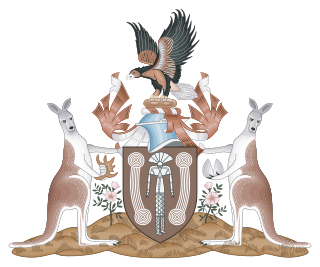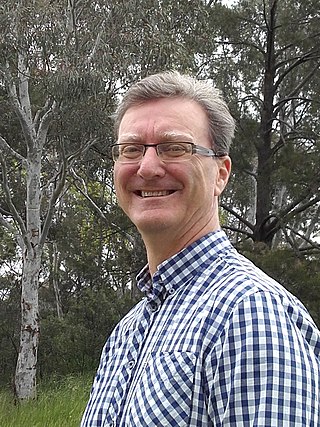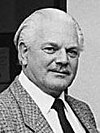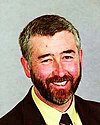The premiers and chief ministers of the Australian states and territories are the heads of the executive governments in the six states and two self-governing territories of Australia. They perform the same function at the state and territory level as the Prime Minister of Australia performs at the national level. The King of Australia and the state governors are the formal repositories of executive power; however, in practice they act only on the advice of state premiers and ministers except in extreme circumstances, such as a constitutional crisis.

The Legislative Assembly for the Australian Capital Territory is the unicameral legislature of the Australian Capital Territory (ACT). It sits in the Legislative Assembly Building on Civic Square, close to the centre of the city of Canberra.
Rosemary Follett is a former Australian politician who was the first Chief Minister of Australian Capital Territory, serving in 1989 and again between 1991 and 1995. She was the first woman to become head of government in an Australian state or territory.

Katherine Ruth Gallagher is an Australian politician who has been serving as the Minister for Finance, Minister for Women, Minister for the Public Service and Vice-President of the Executive Council in the Albanese Government since 2022 having formerly served as the 6th Chief Minister of the Australian Capital Territory from 2011 to 2014. She has been a Senator for the Australian Capital Territory since the 2019 federal election, as a member of the Australian Labor Party (ALP). She previously served in the Senate from 2015 to 2018.
Government in Australia is elected by universal suffrage and Australian women participate in all levels of the government of the nation. In 1902, the newly formed Commonwealth of Australia became the first nation on earth to enact equal suffrage, enabling women to both vote and stand for election alongside men Women have been represented in Australian state parliaments since 1921, and in the Federal Parliament since 1943. The first female leader of an Australian State or Territory was elected in 1989, and the first female Prime Minister took office in 2010. In 2019 for the first time, a majority of members of the Australian Senate were women. At the time of its foundation in 1901, and again from 1952 to 2022, Australia has had a female monarch as ceremonial Head of State, while the first female Governor of an Australian State was appointed in 1991, and the first female Governor-General of Australia took office in 2008.

Andrew James Barr is an Australian politician who has been serving as the 7th Chief Minister of the Australian Capital Territory since 2014. He has been a Labor Party member in the ACT Legislative Assembly since 2006, after being elected on a countback to replace former Treasurer Ted Quinlan, who resigned mid-term. Barr was immediately promoted to Cabinet upon his election. On 11 December 2014 he was elected as Chief Minister after his predecessor, Katy Gallagher, resigned and announced her intention to run for the Senate. In addition to being Chief Minister, he holds the portfolios of Treasurer; Climate Action; Trade, Investment and Economic Development; and Tourism.

The Government of the Australian Capital Territory, also referred to as the Australian Capital Territory Government or ACT Government, is the executive branch of the Australian Capital Territory, one of the territories of Australia. The leader of the party or coalition with the confidence of the Australian Capital Territory Legislative Assembly forms government. Unlike the Australian States and the Northern Territory, the Australian Capital Territory Legislative Assembly directly elects one of their number to be the Chief Minister of the Australian Capital Territory as the head of the Government, rather than being appointed by a Governor or Administrator.
The Australian Capital Territory House of Assembly was the main elected representative body of the Australian Capital Territory between 1975 and 1986, during which time preparation began for the granting of self-government to the Territory. The Assembly had a largely advisory role, with most of the power over the Territory being in the hands of the relevant federal minister.

The Parliament of the Northern Territory is the unicameral legislature of the Northern Territory of Australia. It consists of the Northern Territory Legislative Assembly and the Administrator of the Northern Territory, who represents the Governor-General. It is one of three unicameral parliaments in Australia, along with those of Queensland and the Australian Capital Territory. The Legislative Assembly replaced the previous Legislative Council in 1974. It sits in Parliament House, Darwin.

The deputy chief minister of the Australian Capital Territory is the second-most senior officer in the Government of the Australian Capital Territory. The deputy chief ministership has been a ministerial portfolio since its establishment in 1989. Unlike in other states and territories, the deputy chief minister of the ACT is not nominally appointed by an administrator or vice-regal, but by the chief minister.

A general election for the Australian Capital Territory Legislative Assembly was held on Saturday, 15 October 2016.
The ACT Labor Party, officially known as the Australian Labor Party (Australian Capital Territory Branch) and commonly referred to simply as ACT Labor, is the ACT branch of the Australian Labor Party (ALP). The branch is the current ruling party in the Capital Territory and is led by Andrew Barr, who has concurrently served as chief minister of the Australian Capital Territory since 2014. It is one of two major parties in the unicameral Australian Capital Territory Legislative Assembly, and is currently in a coalition with the ACT Greens.

The 2020 Australian Capital Territory general election was held between 28 September and 17 October 2020 to elect all 25 members of the unicameral ACT Legislative Assembly.

Gordon Ramsay is an Australian politician who served in the Legislative Assembly of the Australian Capital Territory (ACT), representing the Ginninderra electorate from 2016 to 2020. He was elected to be a Minister in the Barr government.
The Second Barr Ministry was the 14th ministry of the Government of the Australian Capital Territory, led by Labor Chief Minister Andrew Barr and his deputy Yvette Berry. It was appointed on 1 November 2016, following the 2016 general election held two weeks earlier. The Greens signed a new formal Parliamentary Agreement with Labor which continued to maintain Green's leader Shane Rattenbury's position in the Ministry, whilst mandating that the Greens not move or support any motion of no confidence in the Labor Government, except in instances of gross misconduct or corruption.
The Second Gallagher Ministry was the 12th ministry of the Government of the Australian Capital Territory, and was led by Labor Chief Minister Katy Gallagher and her deputy Andrew Barr. It was appointed on 7 November 2012, following the 2012 general election held two weeks earlier.

The National Cabinet is the primary Australian intergovernmental decision-making forum composed of the prime minister and state and territory premiers and chief ministers of Australia’s six states and two mainland territories.

The 2024 Australian Capital Territory general election will be held on or before Saturday 19 October 2024 to elect all 25 members of the unicameral ACT Legislative Assembly.























